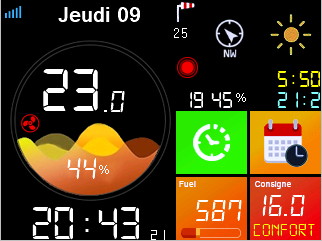Hello,
I want to use dual buttons on Nextion. I’m using physically dual push button and Blynk control . These buttons working synk together. I want to add new buttons on Nextion and want to work synk with bylnk and physical button. How can i make this? Thanks.
I am sharing my code.
#include <WiFi.h>
#include <WiFiClient.h>
#include <BlynkSimpleEsp32.h>
#include <Adafruit_Sensor.h>
#define BLYNK_PRINT Serial
#include <DHT.h>
#include <Adafruit_BMP085.h>
Adafruit_BMP085 bmp;
#define I2C_SCL 19
#define I2C_SDA 18
float dst,bt,bp,ba;
char dstmp[20],btmp[20],bprs[20],balt[20];
bool bmp085_present=true;
#define DHTPIN 33
#define DHTTYPE DHT22
DHT dht(DHTPIN, DHTTYPE); //Defining the pin and the dhttype
BlynkTimer timer;
int toggleState_1 = 1;
int pushButton1State = HIGH;
int toggleState_2 = 1;
int pushButton2State = HIGH;
int toggleState_3 = 1;
int pushButton3State = HIGH;
int toggleState_4 = 1;
int pushButton4State = HIGH;
int wifiFlag = 0;
#define AUTH “sDRszgH6y1vraxIjqzvMJ8ry” // You should get Auth Token in the Blynk App.
#define WIFI_SSID “--” //Enter Wifi Name
#define WIFI_PASS “--” //Enter wifi Password
#define WIFI_LED 2 //D25
#define RELAY_PIN_1 22 //Role1
#define RELAY_PIN_2 23 //Role2
#define RELAY_PIN_3 4 //Role3
#define RELAY_PIN_4 21 //Role4
#define PUSH_BUTTON_1 13 //Buton1
#define PUSH_BUTTON_2 12 //Buton2
#define PUSH_BUTTON_3 26 //Buton3
#define PUSH_BUTTON_4 25 //Buton4
#define VPIN_BUTTON_1 V3 //Blynk Virtual Pin
#define VPIN_BUTTON_2 V4
#define VPIN_BUTTON_3 V7
#define VPIN_BUTTON_4 V8
int analogInput1 = 34 ; //Servis Akü
int analogInput2 = 35 ; //Motor Akü
float correctionfactor = -0.59;
float vout1 = 0.0;
float vin1 = 0.0;
float vout2 = 0.0;
float vin2 = 0.0;
float R1 = 30000; // !! resistance of R1 !!
float R2 = 7350; // !! resistance of R2 !!
int value = 0;
void relayOnOff(int relay){
switch(relay){
case 1:
if(toggleState_1 == 0){
digitalWrite(RELAY_PIN_1, HIGH); // turn on relay 1
toggleState_1 = 1;
}
else{
digitalWrite(RELAY_PIN_1, LOW); // turn off relay 1
toggleState_1 = 0;
}
delay(500);
break;
case 2:
if(toggleState_2 == 0){
digitalWrite(RELAY_PIN_2, HIGH); // turn on relay 2
toggleState_2 = 1;
}
else{
digitalWrite(RELAY_PIN_2, LOW); // turn off relay 2
toggleState_2 = 0;
}
delay(500);
break;
break;
case 3:
if(toggleState_3 == 0){
digitalWrite(RELAY_PIN_3, HIGH); // turn on relay 3
toggleState_3 = 1;
}
else{
digitalWrite(RELAY_PIN_3, LOW); // turn off relay 3
toggleState_3 = 0;
}
delay(500);
break;
case 4:
if(toggleState_4 == 0){
digitalWrite(RELAY_PIN_4, HIGH); // turn on relay 4
toggleState_4 = 1;
}
else{
digitalWrite(RELAY_PIN_4, LOW); // turn off relay 4
toggleState_4 = 0;
}
delay(500);
break;
default : break;
}
}
BLYNK_CONNECTED() {
// Request the latest state from the server
Blynk.syncVirtual(VPIN_BUTTON_1);
Blynk.syncVirtual(VPIN_BUTTON_2);
Blynk.syncVirtual(VPIN_BUTTON_3);
Blynk.syncVirtual(VPIN_BUTTON_4);
}
// When App button is pushed – switch the state
BLYNK_WRITE(VPIN_BUTTON_1) {
toggleState_1 = param.asInt();
digitalWrite(RELAY_PIN_1, toggleState_1);
}
BLYNK_WRITE(VPIN_BUTTON_2) {
toggleState_2 = param.asInt();
digitalWrite(RELAY_PIN_2, toggleState_2);
}
BLYNK_WRITE(VPIN_BUTTON_3) {
toggleState_3 = param.asInt();
digitalWrite(RELAY_PIN_3, toggleState_3);
}
BLYNK_WRITE(VPIN_BUTTON_4) {
toggleState_4 = param.asInt();
digitalWrite(RELAY_PIN_4, toggleState_4);
}
void with_internet(){
if (digitalRead(PUSH_BUTTON_1) == LOW) {
relayOnOff(1);
// Update Button Widget
Blynk.virtualWrite(VPIN_BUTTON_1, toggleState_1);
}
if (digitalRead(PUSH_BUTTON_2) == LOW) {
relayOnOff(2);
// Update Button Widget
Blynk.virtualWrite(VPIN_BUTTON_2, toggleState_2);
}
if (digitalRead(PUSH_BUTTON_3) == LOW) {
relayOnOff(3);
// Update Button Widget
Blynk.virtualWrite(VPIN_BUTTON_3, toggleState_3);
}
if (digitalRead(PUSH_BUTTON_4) == LOW) {
relayOnOff(4);
// Update Button Widget
Blynk.virtualWrite(VPIN_BUTTON_4, toggleState_4);
}
}
void without_internet(){
if (digitalRead(PUSH_BUTTON_1) == LOW) {
relayOnOff(1);
}
if (digitalRead(PUSH_BUTTON_2) == LOW) {
relayOnOff(2);
}
if (digitalRead(PUSH_BUTTON_3) == LOW) {
relayOnOff(3);
}
if (digitalRead(PUSH_BUTTON_4) == LOW) {
relayOnOff(4);
}
}
void checkBlynkStatus() { // called every 3 seconds by SimpleTimer
bool isconnected = Blynk.connected();
if (isconnected == false) {
wifiFlag = 1;
digitalWrite(WIFI_LED, LOW);
}
if (isconnected == true) {
wifiFlag = 0;
digitalWrite(WIFI_LED, HIGH);
}
}
void sendSensor()
{
if (!bmp.begin())
{
Serial.println(“Could not find a valid BMP085 sensor, check wiring!”);
while (1) {}
}
float h = dht.readHumidity();
float t = dht.readTemperature();
if (isnan(h) || isnan(t))
{
Serial.println(“Failed to read from DHT sensor!”);
return;
}
double gamma = log(h/100) + ((17.62*t) / (243.5+t));
double dp = 243.5*gamma / (17.62-gamma);
float bp = bmp.readPressure()/100;
float ba = bmp.readAltitude();
float bt = bmp.readTemperature();
float dst = bmp.readSealevelPressure()/100;
Blynk.virtualWrite(V5 , h); //DH
Blynk.virtualWrite(V6 , t);
Blynk.virtualWrite(V10, bp);
Blynk.virtualWrite(V11, ba);
Blynk.virtualWrite(V12, bt);
Blynk.virtualWrite(V13, dst);
Blynk.virtualWrite(V14, dp);
}
void setup()
{
Serial.begin(9600);
pinMode(RELAY_PIN_1, OUTPUT);
pinMode(PUSH_BUTTON_1, INPUT_PULLUP);
digitalWrite(RELAY_PIN_1, toggleState_1);
pinMode(RELAY_PIN_2, OUTPUT);
pinMode(PUSH_BUTTON_2, INPUT_PULLUP);
digitalWrite(RELAY_PIN_2, toggleState_2);
pinMode(RELAY_PIN_3, OUTPUT);
pinMode(PUSH_BUTTON_3, INPUT_PULLUP);
digitalWrite(RELAY_PIN_3, toggleState_3);
pinMode(RELAY_PIN_4, OUTPUT);
pinMode(PUSH_BUTTON_4, INPUT_PULLUP);
digitalWrite(RELAY_PIN_4, toggleState_4);
pinMode(WIFI_LED, OUTPUT);
dht.begin();
delay(10);
timer.setInterval(1000L, sendSensor);
Wire.begin(I2C_SDA, I2C_SCL);
WiFi.begin(WIFI_SSID, WIFI_PASS);
timer.setInterval(3000L, checkBlynkStatus); // check if Blynk server is connected every 3 seconds
Blynk.config(AUTH);
}
void loop()
{
if (WiFi.status() != WL_CONNECTED)
{
Serial.println(“Not Connected”);
}
else
{
Serial.println(” Connected”);
Serial.println(vin1); // sleep…
Serial.println(vin2); // sleep…
Blynk.run();
}
timer.run(); // Initiates SimpleTimer
if (wifiFlag == 0)
with_internet();
else
without_internet();
value = analogRead(analogInput1);
vout1 = (value * 3.3) / 4095.0;
vin1 = vout1 / (R2/(R1+R2));
value = analogRead(analogInput2);
vout2 = (value * 3.3) / 4095.0;
vin2 = vout2 / (R2/(R1+R2));
vin1 = vin1 – correctionfactor;
vin2 = vin2 – correctionfactor;
Blynk.virtualWrite(V0, vin1);
Blynk.virtualWrite(V16, vin2);
Serial.println(vin1); // sleep…
Serial.println(vin2); // sleep…
delay(500);
}


